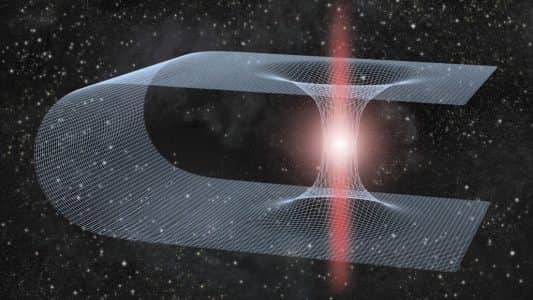Dark Vortex in the Atmosphere of Neptune Spotted by Hubble - Dispatch Weekly
June 26, 2016 - Reading time: 2 minutes

The Hubble Space Telescope has spotted a dark vortex in the atmosphere of Neptune – a feature similar to the one spotted by Voyager 2 during its flyby of the planet in 1989 and by the Hubble Space Telescope in 1994.
Neptune’s dark vortices are high-pressure systems and are usually accompanied by bright “companion clouds,” which are also now visible on the distant planet. The bright clouds form when the flow of ambient air is perturbed and diverted upward over the dark vortex, causing gases to likely freeze into methane ice crystals.
“Dark vortices coast through the atmosphere like huge, lens-shaped gaseous mountains,” explains University of California at Berkeley research astronomer Mike Wong. “And the companion clouds are similar to so-called orographic clouds that appear as pancake-shaped features lingering over mountains on Earth.”
Beginning in July 2015, bright clouds were again seen on Neptune by several observers, from amateurs to astronomers at the W. M. Keck Observatory in Hawaii. Astronomers suspected that these clouds might be bright companion clouds following an unseen dark vortex. Neptune’s dark vortices are typically only seen at blue wavelengths, and only Hubble has the high resolution required for seeing them on distant Neptune.
In September 2015, the Outer Planet Atmospheres Legacy (OPAL) program, a long-term Hubble Space Telescope project that annually captures global maps of the outer planets, revealed a dark spot close to the location of the bright clouds, which had been tracked from the ground. By viewing the vortex a second time, the new Hubble images confirm that OPAL really detected a long-lived feature.
The new data enabled the team to create a higher-quality map of the vortex and its surroundings. Neptune’s dark vortices have exhibited surprising diversity over the years, in terms of size, shape, and stability (they meander in latitude, and sometimes speed up or slow down). They also come and go on much shorter timescales compared to similar anticyclones seen on Jupiter; large storms on Jupiter evolve over decades.
Planetary astronomers hope to better understand how dark vortices originate, what controls their drifts and oscillations, how they interact with the environment, and how they eventually dissipate, according to UC Berkeley doctoral student Joshua Tollefson, who was recently awarded a prestigious NASA Earth and Space Science Fellowship to study Neptune’s atmosphere. Measuring the evolution of the new dark vortex will extend knowledge of both the dark vortices themselves, as well as the structure and dynamics of the surrounding atmosphere.

DW Staff
David Lintott is the Editor-in-Chief, leading our team of talented freelance journalists. He specializes in covering culture, sport, and society. Originally from the decaying seaside town of Eastbourne, he attributes his insightful world-weariness to his roots in this unique setting.

_1.jpg)


